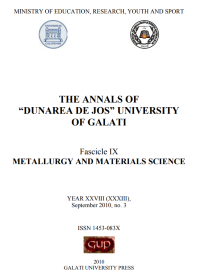Influence of SiC/Ni Nanocomposite Coatings on SrB Attachment and Biofilm Formation
Abstract
Bacteria adhesion is a very complicated process affected by many factors: bacterial/material properties and environment. Materials characteristics and chemistry of surfaces are the most important factors in bacterial adhesion and biofilm growth. Cells initially attach by physico–chemical interactions or extracellular matrix protein secretion to form a cell monolayer, in which cells express pili and have twitching motility and/or the ability to undergo chemotaxis. Cells proliferate in the monolayer and other microbes attach to form an active biofilm, the development and distortion of which is influenced by environmental factors such as hydrodynamic and mechanical stress. Cells in the mature biofilm are motile and undergo chemotaxis, which leads to spreading of biomass and an increased rate of horizontal gene transfer. As cells die, active bioconversion and/or biodegradation leads to solute transfer to or from the bulk liquid which results in eventual biofilm detachment.
The work was focused on performing surface modifications studies by codeposition of dispersed nano particles with metals in order to observe the influence of materials structure (nano-structured coatings prepared) on bacteria cells (Sulphate Reducing Bacteria) attachment. Sessile bacteria on coupons were stained with 4, 6-diamidino-2- phenylindol (DAPI) and visualized by EFM as well as AFM. These types of bacteria are well known as very corrosive for metals in natural seawater.
Downloads
References
[2]. Flemming HC and Wingender J., Water Sci. Technol. 43, (1999) 9-16.
[3]. Damien Feron, Chantal Compère, Isabelle Dupont, Michel Magot, "Biodétération des matériaux métalliques ou biocorrosion", in Corrosion des métaux et alliages: Mécanismmes et phénomènes, Edited by G. Béranger and Henri Mazille, Lavoisier 2002, ISBN 2-7462-0466-5.
[4]. B. J. Little, R. I. Ray, P. A. Wagner, J. Jones-Mehan, C. C. Lee and F. Mansfeld; Biofouling, Vol.13 , 4 (1999), 301-321.
[5]. Stephen L. Hodson, Christipher M. Burke, Andrew P. Bissett; Aquaculture 184, (2000) 227-290.
[6]. Mohamed O. Saeed, A.T. Jamaluddin, I. A. Tisan, D. A. Lawrence, M.M. Al-Amri, Kamran Chida; Desalination 128, (2000) 177-190.
[7]. Lidia Benea, Pier Luigi Bonora, Alberto Borello, Stefano Martelli, Wear 249 (2002).
[8]. Lidia Benea, Pier Luigi Bonora, Alberto Borello, Stefano Martelli, Francois Wenger, Pierre Ponthiaux, Jacques Galland, Solid State Ionics 151 (2002) 89.
[9]. L. Benea, M. Mardare, B. Tribollet, Dispersed nano-sized SiC in nickel to improve the corrosion properties of composite coatings; CD Proceeding Eurocorr 2009, 5th-10th September NiceFrance.
[10]. L. Benea, A. Ciubotariu, B. Tribollet, W. Sand, Surface modifications to influence biofilm formation on material surfaces; CD Proceeding Eurocorr 2009, 5th-10th September Nice-France.
[11]. Bernardez L A, de Andrade Lima LRP, Almeida PF., 2007. Corrosion of stainless steels exposed to seawater containing sulfate reducing bacteria. Brazilian Journal of Petroleum and Gas. 1:51-58.



